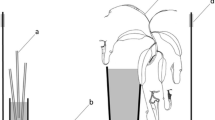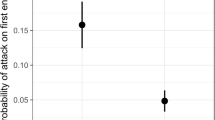Abstract
Invasive ant species have general diet and nest requirements, which facilitate their establishment in novel habitats and their dominance over many native ants. The Asian needle ant, Pachycondyla chinensis, native throughout Australasia was introduced to the southeastern US where it has become established in woodland habitats, nests in close proximity to and consumes subterranean termites (Rhinotermitidae). P. chinensis do not occur in habitats lacking Rhinotermitidae. We suggest that subterranean termites are critical for P. chinensis success in new habitats. We demonstrate that P. chinensis is a general termite feeder, retrieving Reticulitermes virginicus five times more often than other potential prey near P. chinensis colonies. Odors produced by R. virginicus workers, as well as other potential prey, attract P. chinensis. Furthermore, P. chinensis occupy R. virginicus nests in the lab and field and display behaviors that facilitate capture of R. virginicus workers and soldiers. Termites are an abundant, high quality, renewable food supply, in many ways similar to the hemipteran honeydew exploited by most other invasive ant species. We conclude that the behavior of P. chinensis in the presence of termites increases their competitive abilities in natural areas where they have been introduced.

Similar content being viewed by others
References
Abbott K.L. and Green P.T. 2007. Collapse of an ant-scale mutualism in a rainforest on Christmas Island. Oikos 116: 1238–1246
Agbogba C. 1992. Settlement in the prey termite nest by the ponerine ant Pachycondyla caffraria (Smith), and tandem running signal analysis for the following ant. J. Ethol. 10: 133–137
Ambrose H., Ambrose K., Emlen D. and Bright K. 2002. A Handbook of Biological Investigation. Hunter Textbooks Inc. Winston-Salem, NC. 188 pp
Bayliss J. and Fielding A. 2002. Termitophagous foraging by Pachycondyla analis (Formicidae, Ponerinae) in a Tanzanian coastal dry forest. Sociobiology 39: 103–122
Bhatkar A. and Whitcomb W.H. 1970. Artificial diet for rearing various species of ants. Fla. Entomol. 53: 229–232
Blüthgen N., Gebauer G. and Fiedler K. 2003. Disentangling a rainforest food web using stable isotopes: dietary diversity in a species-rich ant community. Oecologia 137: 426–435
Bolton B. 1995. A taxonomic and zoogeographical census for the extant ant taxa (Hymentoptera, Formicidae). J. Nat. Hist. 29: 1037–1056
Buckley R. and Gullan P. 1991. More aggressive ant species (Hymenoptera: Formicidae) provide better protection for soft scales and mealybugs (Homoptera: Coccidae, Pseudococcidae). Biotropica 23: 282–286
Buczkowski G. and Bennett G. 2007. Protein marking reveals predation on termites by the woodland ant, Aphaenogaster rudis. Insect. Soc. 54: 219–224
Buczkowski G. and Bennett G. 2008. Behavioral interactions between Aphaenogaster rudis (Hymenoptera: Formicidae) and Reticulitermes flavipes (Isoptera: Rhinotermitidae): the importance of physical barriers. J. Insect Behav. 21: 296–305
Corbara B. and Dejean A. 2000. Adaptive behavioral flexibility of the ant Pachycondyla analis (= Megaponera foetens) (Formicidae: Ponerinae) during prey capture. Sociobiology 36: 465–483
Davidson DW. 1997. The role of resource imbalances in the evolutionary ecology of tropical arboreal ants. Biol. J. Linn. Soc. 61: 153–181
Dejean A., Durand J.L., and Bolton B. 1996. Ants inhabiting Cubitermes termitaries in African rain forests. Biotropica 28: 701–713
Dejean A. and Fénéron R. 1999. Predatory behaviour in the ponerine ant, Centromyrmex bequaerti: a case of termitolesty. Behav. Process. 47: 125–133
Dejean A., Kenne M., and Moreau C.S. 2007. Predatory abilities favour the success of the invasive ant Pheidole megacephala in an introduced area. J. Appl. Entomol. 131: 625–629
Eggleton P., Bignell D.E., Sands W.A., Mawdsley N.A., Lawton, Wood T.G., and Bignell N.C. 1996. The diversity, abundance and biomass of termites under differing levels of disturbance in the Mbalmayo Forest Reserve, southern Cameroon. Phil. Trans. R. Soc. Lond. B. 351: 51–68
García Pérez J.A., Blanco Pinon A., Mercado Hernández R. and Badii M. 1997. Predation of Pachycondyla harpax Fabr. (Hymenoptera: Ponerinae) on Gnathamitermes tubiformans Buckley (Isoptera: Termitidae) under conditions of captivity. Southwest. Entomol. 22: 345–353
Grover C.D., Kay A.D., Monson J.A., Marsh T.C., and Holway D.A. 2007. Linking nutrition and behavioural dominance: carbohydrate scarcity limits aggression and activity in Argentine ants. Proc. R. Soc. B. 274: 2951–2957
Guénard B. and Dunn R.R. 2010. A new (old), invasive ant in the hardwood forests of Eastern North America and its potentially widespread impacts. PLoS ONE 5: e11614. doi:10.1371/journal.pone.0011614
Hansen R.A., Williams R.S., Degenhardt D.C. and Lincoln D.E. 2001. Non-litter effects of elevated CO2 on forest floor microarthropod abundances. Plant Soil 236: 139–144
Helms K.R. and Vinson S.B. 2002. Widespread association of the invasive ant Solenopsis invicta with an invasive mealybug. Ecology 83: 2425–2438
Helms K.R. and Vinson S.B. 2008. Plant resources and colony growth in an invasive ant: The importance of honeydew-producing Hemiptera in carbohydrate transfer across trophic levels. Environ. Entomol. 37: 487–493
Hölldobler B. and Wilson E.O. 1990. The Ants. Belknap Press, Cambridge, Massachusetts, 732 pp
Holway D.A, Lach L., Suarez A.V., Tsutsui N.D. and Case T.J. 2002. The causes and consequences of ant invasions. Annu. Rev. Ecol. Syst. 33: 181–233
Horn S. and Hanula J.L. 2002. Life history and habitat associations of the broad wood cockroach, Parcoblatta lata (Blattaria: Blattellidae) and other native cockroaches in the coastal plain of South Carolina. Ann. Entomol. Soc. Am. 95: 665–671
Howard R.W., Jones S.C., Mauldin J.K. and Beal R.H. 1982. Abundance, distribution, and colony size estimates for Reticulitermes spp (Isoptera, Rhinotermitidae) in Southern Mississippi. Environ. Entomol. 11: 1290–1293
Jaffe K., Ramos C. and Issa S. 1995. Trophic interactions between ants and termites that share common nests. Ann. Entomol. Soc. Am. 88: 328–333
Kenis M., Auger-Rozenberg M.A., Roques A., Timms L., Péré C., Cock M., Settele J., Augustin S. and López-Vaamonde C. 2009. Ecological effects of invasive alien insects. Biol. Invasions 11: 21–45
Kubota M., Imai H.T., Kondo M., Onoyama K., Ogata K., Terayama M. and Yoshimura M. 2003. Japanese Ant Image Database. Japanese Ant Database Group (JADG).
Lach L. 2003. Invasive ants: unwanted partners in ant-plant interactions? Ann. Miss. Bot. Gard. 90: 91–108
Lach L. 2005. Interference and exploitation competition of three nectar-thieving invasive ant species. Insect. Soc. 52: 257–262
Leal I.R. and Oliveira P.S. 1995. Behavioral ecology of the neotropical termite hunting ant Pachycondyla (=Termitopone) marginata - colony founding, group-raiding and migratory patterns. Behav. Ecol. Sociobiol. 37: 373–383
Martin P. and Bateson P. 1993. Measuring Behavior – An Introductory Guide. Cambridge University Press. 222 pp
Matsuura K. 2002. Colony-level stabilization of soldier head width for head-plug defense in the termite Reticulitermes speratus (Isoptera : Rhinotermitidae). Behav. Ecol. Sociobiol. 51: 172–179
Matsuura K., Vargo E., Kawatsu K., Labadie P., Nakano H., Yashiro T. and Tsuji K. 2009. Queen succession through asexual reproduction in termites. Science 323: 1687–1687
Mill A.E. 1984. Predation by the ponerine ant Pachycondyla commutata on termites of the genus Syntermes in Amazonian rain-forest. J. Nat. Hist. 18: 405–410
Mittler T.E. 1958. Studies on the feeding and nutrition of Tuberolachnus salignus (Gmelin) (Homoptera, Aphididae) II. The nitrogen and sugar composition of ingested phloem sap and excreted honeydew. J. Exp. Biol. 35: 74–84
Morales M.A. 2000. Mechanisms and density dependence of benefit in an ant-membracid mutualism. Ecology 81: 482–489
Nelder M., Paysen E., Zungoli P. and Benson E. 2006. Emergence of the introduced ant Pachycondyla chinensis (Formicidae: Ponerinae) as a public health threat in the southeastern United States. J. Med. Entomol. 43: 1094–1098
Palmer T.M. 2003. Spatial habitat heterogeneity influences competition and coexistence in an African acacia ant guild. Ecology 84: 2843–2855
Paul J. and Roces F. 2003. Fluid intake rates in ants correlate with their feeding habits. J. Insect Physiol. 49: 347–357
Prestwich G.D. 1984. Defense mechanisms of termites. Annu. Rev. Entomol. 29: 201–232
Rojas M. and Morales-Ramos J. 2001. Bait matrix for delivery of chitin synthesis inhibitors to the formosan subterranean termite (Isoptera: Rhinotermitidae). J. Econ. Entomol. 94: 506–510
Rowles A.D. and Silverman J. 2009. Carbohydrate supply limits invasion of natural communities by Argentine ants. Oecologia 161: 161–171
SAS Institute. 2007. JMP, Version 7. SAS Institute Inc., Cary, NC
Smith M.R. 1934. Ponerine ants of the genus Euponera in the United States. Ann. Entomol. Soc. Am. 27: 557–564
Sogbesan A.O. and Ugwumba A.A.A. 2008. Nutritional values of some non-conventional animal protein feedstuffs used as fishmeal supplement in aquaculture practices in Nigeria. Turk. J. Fish. Aqua. Sci. 8: 159–164
Su N.-Y., Ban P.M. and Scheffrahn R.H. 1993. Foraging populations and territories of the eastern subterranean termite (Isoptera: Rhinotermitidae) in southeastern Florida. Environ. Entomol. 22 : 1113–1117
Suzzoni J.P, Schatz B. and Dejean A. 2000. Essential and alternative prey in a ponerine ant: variations according to the colony life cycle. C.R. Acad. Sci. III 323: 1003–1008
Szalanski A.L., Austin J.W. and Ovens C.B. 2003. Identification of Reticulitermes spp. (Isoptera: Reticulitermatidae) from south central United States by PCR-RFLP. J. Econ. Entomol. 96: 1514–1519
Tillberg C.V., Holway D.A., LeBrun E.G. and Suarez A.V. 2007. Trophic ecology of invasive Argentine ants in their native and introduced ranges. Proc. Natl. Acad. Sci. U.S.A. 104: 20856–20861
Walsh P.S., Metzger D.A. and Higuchi R. 1991. Chelex-100 as a medium for simple extraction of DNA for PCR-based typing from forensic material. Biotechniques 10: 506–513
Watt A.D., Stork N.E., Eggleton P., Srivastava D., Bolton B., Larsen T.B., Brendell M.J. and Bignell D.E. 1997. Impact of forest loss and regeneration on insect abundance and diversity. In: Forests and Insects (Watt A.D., Stork N.E. and Hunter M.D., Eds), Chapman & Hall, London, U.K. pp 273–286
Wheeler W.M. 1930. A list of the known Chinese ants. Peking Nat. Hist. Bull. 5: 53–81
Wheeler W.M. 1936. Ecological relations of Ponerine and other ants to termites. Proc. Am. Acad. Arts Sci. 71: 159–242
Wilson E.O. and Brown W.L. 1984. Behavior of the cryptobiotic predaceous ant Eurhopalothrix heliscata, n. sp. (Hymenoptera: Formicidae: Basicerotini). Insect. Soc. 31: 408–428
Wood T.G. and Sands W.A. 1978. The role of termites in ecosystems. In: Production Ecology of Ants and Termites (Brian M.V., Ed), Cambridge University Press, Cambridge, U.K. pp 245–292
Zungoli P., Paysen E., Benson E. and Nauman J. 2005. Colony and habitat characteristics of Pachycondyla chinensis (Hymenoptera: Formicidae). In: Proc. 5th Int. Conf. Urban Pests (Young-Lee C. and Robinson W.H., Eds), Perniagaan Ph’ng @ P&Y Design Network, Malaysia. p 571
Acknowledgments
We thank R. Dunn and E. Vargo for providing improvements to the manuscript. J. Brightwell, M. Green, B. Guénard, P. Labadie E. Spicer and D. Tarpy provided technical assistance and C. Arellano provided statistical advice. This study was supported by the Blanton J. Whitmire Endowment at North Carolina State University.
Author information
Authors and Affiliations
Corresponding author
Rights and permissions
About this article
Cite this article
Bednar, D.M., Silverman, J. Use of termites, Reticulitermes virginicus, as a springboard in the invasive success of a predatory ant, Pachycondyla (=Brachyponera) chinensis . Insect. Soc. 58, 459–467 (2011). https://doi.org/10.1007/s00040-011-0163-0
Received:
Revised:
Accepted:
Published:
Issue Date:
DOI: https://doi.org/10.1007/s00040-011-0163-0




